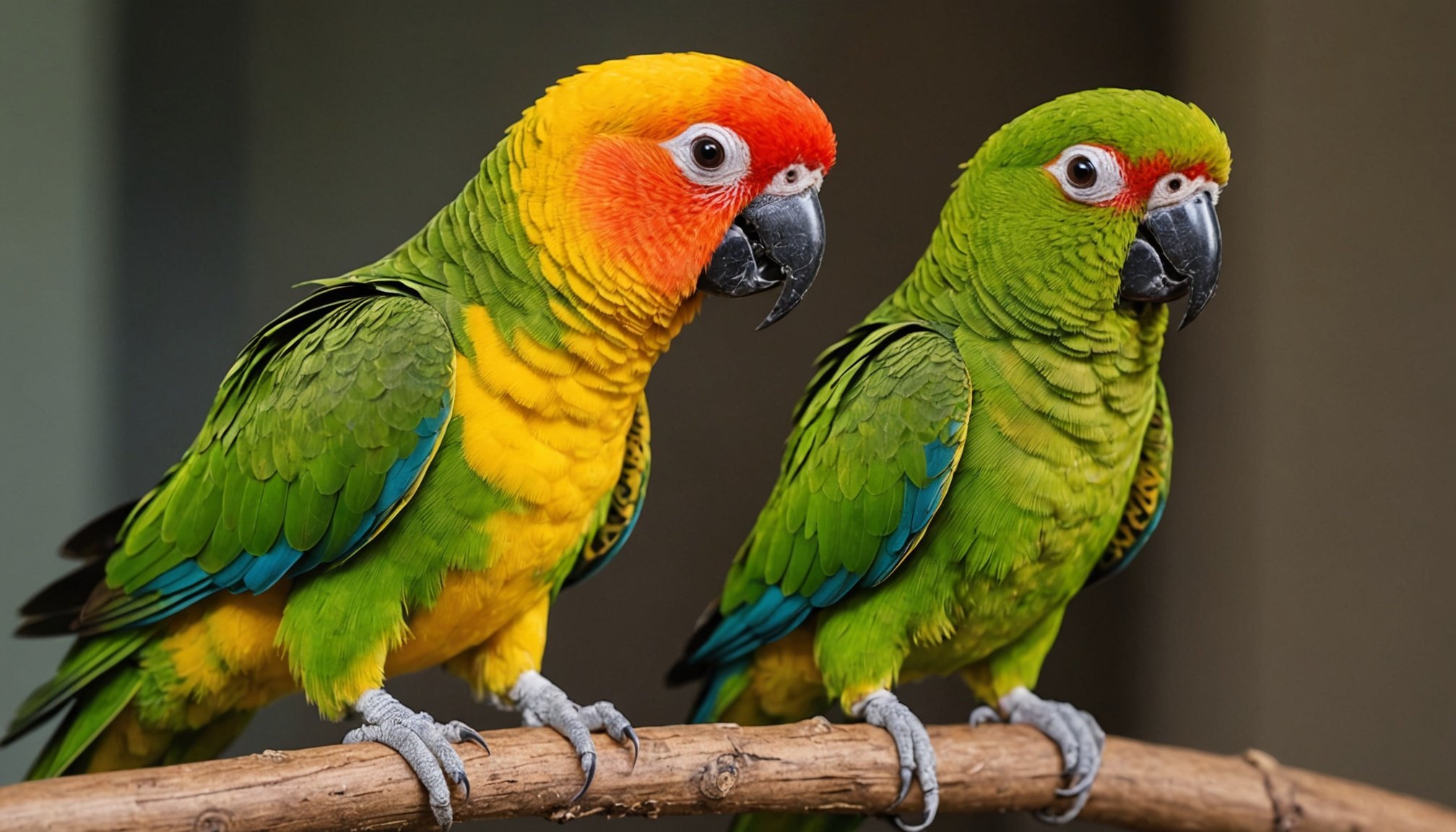Understanding Sound Imitation in Conures
Sound imitation is an intriguing aspect of conure behavior, reflecting the species’ advanced ability for bird mimicry. These birds are particularly skilled at replicating various sounds they encounter, from household noises to human speech. The extent of a conure’s mimicry can be influenced by several psychological factors. For example, a strong bond between a conure and its owner or frequent interaction can significantly enhance this ability. Social environments that encourage interaction are essential, as these birds naturally learn through observation and participation in their surroundings.
The importance of social interaction in sound learning cannot be overstated. Conures are highly social birds, thriving in communities where they can observe and imitate peers. This mimicry is not just a whimsical trait but plays a crucial role in their communication methods within the flock. By interpreting and imitating sounds, conures engage and bond with their human companions or fellow birds.
Have you seen this : The ultimate handbook for recognizing and treating common skin problems in british shorthair cats
Understanding these dynamics can help owners facilitate better learning environments, ensuring their pets reach their full sound imitation potential. Recognising a conure’s unique mimicry skills opens up opportunities for engaging and meaningful interaction. Such engagement enriches both the bird’s life and the owner’s experience, fostering a closer, more interactive relationship.
Preparing for Training Your Conure
Establishing the right environment is critical for effective parrot training preparation. A calm and distraction-free area encourages focus. Remove any potential disturbances that might steal your conure’s attention, as a peaceful setting is beneficial for sound learning.
Also read : The definitive handbook for boosting your indoor ragdoll cat’s happiness and mental stimulation
Training tools, such as clickers and reward-based toys, play an instrumental role in enhancing learning outcomes. These tools help facilitate clear communication between you and your conure, making it easier for the bird to understand what’s expected. Additionally, providing an assortment of engaging toys can stimulate your conure’s curiosity, promoting spontaneous sound mimicry.
To maximally benefit from training tools, consistency in your training routine is paramount. Establish a designated training time each day to set clear expectations for your conure. Regular sessions help imprint sound imitation cues and patterns, making it easier for your bird to learn over time.
By intertwining these elements, you create a structured and encouraging environment that promotes sound mimicry. When done mindfully, conure training preparation becomes not just a teaching moment but an enriching experience that fortifies the bond between you and your feathered friend. Consistent and supportive training not only enhances learning but also elevates the joy of owning a conure.
Step-by-Step Training Techniques
Creating a productive training environment is just the beginning. Once you’re set, honing specific training techniques is key to developing your conure’s sound mimicry abilities. Let’s explore clear steps to enhance your feathered friend’s learning journey.
Initial Sound Exposure
Introducing your conure to new sounds forms the foundation of effective training. Carefully select sounds that are clear and replicate them consistently. This exposure is pivotal; it not only stimulates interest but sets a clear auditory target for your bird to mimic. Gradually introduce these sounds in a gentle, controlled manner to avoid overwhelming your pet.
Reinforcement Strategies
Positive reinforcement is crucial for teaching your conure to associate sounds with rewards. Treats and praise are excellent motivators. Timing here is everything; reward your bird immediately upon successful sound mimicry. This establishes a direct connection between the action and the reward. Adapt your reinforcement based on your conure’s progress, offering consistent encouragement along the way.
Repetition and Consistency
Regular practice sessions are fundamental to skill development in birds. Incorporate diverse activities to maintain your conure’s interest and motivation. Balance is essential—challenge your bird without causing stress. A well-structured routine ensures your pet remains engaged, paving the way for incremental improvements in sound mimicry.
Common Mistakes to Avoid
Understanding potential training mistakes is vital for effective conure training. Recognizing when a conure is feeling stressed or frustrated can significantly improve your approach. Stress signs include rapid head bobbing, feather plucking, or excessive noise. Ignoring these signs can lead to negative associations with training, impacting conure behavior. Prioritizing your bird’s comfort will foster a supportive learning environment.
A common conure training error is misinterpreting bird behavior. For instance, a conure may not imitate sounds immediately, leading to the wrong assumption that it’s uninterested. Patience is key; some birds take longer to respond. Observing your bird’s interactions and preferences can offer insights into their learning pace, aiding in more tailored training sessions.
Overloading a training session with numerous sounds may seem efficient but can cause confusion. Stick to a manageable number of new sounds to keep your conure focused and prevent overwhelm. It’s important to build confidence by mastering a few sounds before introducing more.
By being mindful of these pitfalls, you enhance your training outcomes. Cultivating a positive, understanding relationship with your conure ensures more successful sound imitation and a joyful shared experience with your feathered friend.
Addressing Challenges in Sound Imitation
Navigating training challenges in sound imitation can be daunting for conure owners. Initially, identifying potential obstacles is crucial. Issues may arise from environmental factors, like too much noise, or personal factors, such as individual conure behavior and temperament. It’s vital to observe your bird closely to understand such barriers.
When faced with resistance or a lack of interest, adopting flexible strategies is essential. Introducing interactive elements—like music or engaging sounds—can spark curiosity and motivation. Rotating these elements helps keep sessions fresh and appealing.
Understanding and adapting to each bird’s temperament is another critical aspect. Some conures may require more time and patience, while others might respond quickly. Tailoring your approach to the specific needs and pace of your bird can significantly enhance learning outcomes. Encourage small successes and reward every achievement to build confidence.
In addressing sound imitation challenges, it’s essential to remain patient and adaptable. Adjusting your methods in response to your conure’s cues not only resolves issues more efficiently but also strengthens the bond between you and your feathered companion, fostering a supportive and enjoyable learning environment.
Resources for Conure Owners
For conure owners seeking to enhance their sound imitation training, accessing the right resources is essential. Leveraging various training resources can significantly improve outcomes, making the journey enjoyable for both you and your bird.
Begin with recommended books and online courses that delve deep into bird training intricacies. These materials often provide structured guidance, effective techniques, and in-depth understanding of conure behavior. Resources like “The Parrot Wizard’s Guide to Well-Behaved Parrots” offer invaluable insights.
Joining local and online communities provides a network of fellow conure enthusiasts who share advice and experiences. Platforms like forums and Facebook groups can be excellent sources of communal support and motivation. Engaging in these settings allows you to learn from shared successes and challenges, enabling more informed training techniques.
Lastly, seeking expert guidance offers personalized recommendations tailored to your bird’s specific needs. Consult experienced avian trainers or behaviorists who offer tailored advice. Their expertise can provide clarity on overcoming particular training challenges, ensuring a smoother and more efficient learning process for your conure.
By utilizing these resources, owners can build a supportive framework around conure training, fostering an environment rich in learning and bonding opportunities.











